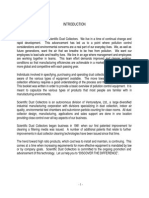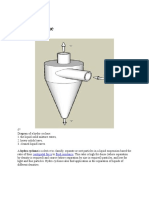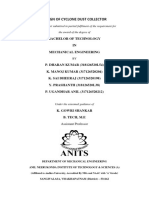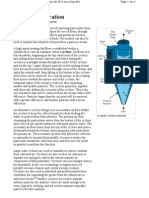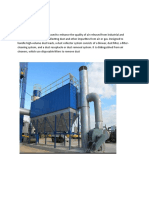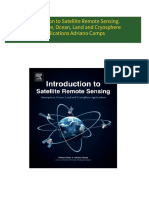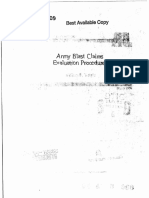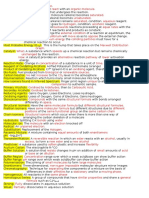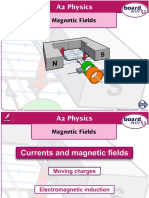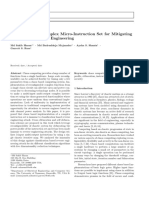0 ratings0% found this document useful (0 votes)
12 viewsCyclonic Separation Copie
Cyclonic Separation Copie
Uploaded by
cassie.kocCyclonic separation uses rotational forces and gravity to separate mixtures of solids and fluids without filters. In a cyclone separator, the fluid mixture enters from the top and spirals downwards, where the centrifugal forces cause heavier particles to impact the outer walls and collect at the bottom while the purified fluid exits through the center. An alternative design introduces a secondary airflow to keep particles from abrading the walls and allow horizontal mounting. Cyclones are widely used in industrial applications like oil refining, cement production, and kitchen ventilation as well as household vacuum cleaners.
Copyright:
© All Rights Reserved
Available Formats
Download as PDF, TXT or read online from Scribd
Cyclonic Separation Copie
Cyclonic Separation Copie
Uploaded by
cassie.koc0 ratings0% found this document useful (0 votes)
12 views2 pagesCyclonic separation uses rotational forces and gravity to separate mixtures of solids and fluids without filters. In a cyclone separator, the fluid mixture enters from the top and spirals downwards, where the centrifugal forces cause heavier particles to impact the outer walls and collect at the bottom while the purified fluid exits through the center. An alternative design introduces a secondary airflow to keep particles from abrading the walls and allow horizontal mounting. Cyclones are widely used in industrial applications like oil refining, cement production, and kitchen ventilation as well as household vacuum cleaners.
Copyright
© © All Rights Reserved
Available Formats
PDF, TXT or read online from Scribd
Share this document
Did you find this document useful?
Is this content inappropriate?
Cyclonic separation uses rotational forces and gravity to separate mixtures of solids and fluids without filters. In a cyclone separator, the fluid mixture enters from the top and spirals downwards, where the centrifugal forces cause heavier particles to impact the outer walls and collect at the bottom while the purified fluid exits through the center. An alternative design introduces a secondary airflow to keep particles from abrading the walls and allow horizontal mounting. Cyclones are widely used in industrial applications like oil refining, cement production, and kitchen ventilation as well as household vacuum cleaners.
Copyright:
© All Rights Reserved
Available Formats
Download as PDF, TXT or read online from Scribd
Download as pdf or txt
0 ratings0% found this document useful (0 votes)
12 views2 pagesCyclonic Separation Copie
Cyclonic Separation Copie
Uploaded by
cassie.kocCyclonic separation uses rotational forces and gravity to separate mixtures of solids and fluids without filters. In a cyclone separator, the fluid mixture enters from the top and spirals downwards, where the centrifugal forces cause heavier particles to impact the outer walls and collect at the bottom while the purified fluid exits through the center. An alternative design introduces a secondary airflow to keep particles from abrading the walls and allow horizontal mounting. Cyclones are widely used in industrial applications like oil refining, cement production, and kitchen ventilation as well as household vacuum cleaners.
Copyright:
© All Rights Reserved
Available Formats
Download as PDF, TXT or read online from Scribd
Download as pdf or txt
You are on page 1of 2
Cyclonic separation
A simple cyclone separator
Cyclonic separation is a method of removing particulates from
an air, gas or liquid stream, without the use of filters, through
vortex separation. When removing particulate matter from
liquids, a hydrocyclone is used; while from gas, a gas cyclone
is used. Rotational effects and gravity are used to separate
mixtures of solids and fluids. The method can also be used to
separate fine droplets of liquid from a gaseous stream.
A high speed rotating (air) flow is established within a cylindrical or
conical container called a cyclone. Air flows in a helical pattern,
beginning at the top (wide end) of the cyclone and ending at
the bottom (narrow) end before exiting the cyclone in a straight
stream through the center of the cyclone and out the top. Larger
(denser) particles in the rotating stream have too much inertia to follow
the tight curve of the stream, and strike the outside wall, then fall to the
bottom of the cyclone where they can be removed. In a conical system, as
the rotating flow moves towards the narrow end of the cyclone, the
rotational radius of the stream is reduced, thus separating smaller
and smaller particles. The cyclone geometry, together with flow
rate, defines the cut point of the cyclone. This is the size of particle that
will be removed from the stream with a 50% efficiency. Particles larger than the cut
point will be removed with a greater efficiency, and
smaller particles with a lower efficiency.
Airflow diagram for Aerodyne cyclone in standard
vertical position. Secondary air flow is injected to
reduce wall abrasion.
Airflow diagram for Aerodyne cyclone in horizontal
position, an alternate design. Secondary air flow is
injected to reduce wall abrasion, and to help move
collected particulates to hopper for extraction.
An alternative cyclone design uses a secondary air
flow within the cyclone to keep the collected particles
from striking the walls, to protect them from abrasion.
The primary air flow containing the particulates
enters from the bottom of the cyclone and is forced
into spiral rotation by stationary spinner vanes. The
secondary air flow enters from the top of the cyclone
and moves downward toward the bottom, intercepting
the particulate from the primary air. The secondary air
flow also allows the collector to optionally be
mounted horizontally,
because it pushes the
particulate toward the
collection area, and does not
rely solely on gravity to
perform this function.
Large scale cyclones are used
in sawmills to remove
sawdust from extracted air.
Cyclones are also used in oil
refineries to separate oils and
gases, and in the cement
industry as components of
kiln preheaters. Cyclones are increasingly used in the household, as the core technology in
bagless types of portable vacuum cleaners and central vacuum cleaners. Cyclones are also used
in industrial and professional kitchen ventilation for separating the grease from the exhaust air
in extraction hoods.[1] Smaller cyclones are used to separate airborne particles for analysis.
Some are small enough to be worn clipped to clothing, and are used to separate respirable
particles for later analysis.
Similar separators are used in the oil refining industry (e.g. for Fluid catalytic cracking) to
achieve fast separation of the catalyst particles from the reacting gases and vapors.[2]
James Dyson has become a billionaire from developing and marketing bagless vacuum cleaners
based on cyclonic separation of dust, initially inspired by seeing sawdust separator at a sawmill.
Analogous devices for separating particles or solids from liquids are called hydrocyclones or
hydroclones. These may be used to separate solid waste from water in wastewater and sewage
treatment.
From Wikipedia
You might also like
- CSWIP 3.0 - Visual Welding Inspector 2015Document261 pagesCSWIP 3.0 - Visual Welding Inspector 2015Agung Satya100% (7)
- A Scientific Review of Dust Collection BookDocument81 pagesA Scientific Review of Dust Collection Bookyilo2000100% (1)
- Cyclone SeparatorDocument24 pagesCyclone SeparatorRahul Narang100% (1)
- The Real Dirt On DustDocument80 pagesThe Real Dirt On DusttuyentruongNo ratings yet
- SN008a-En-EU - NCCI - Buckling Lengths of Columns - Rigorous ApproachDocument8 pagesSN008a-En-EU - NCCI - Buckling Lengths of Columns - Rigorous ApproachWNo ratings yet
- 332 Cyclone SeparatorsDocument2 pages332 Cyclone SeparatorsJoshi Dhvanit100% (1)
- Cyclone SeparatorDocument3 pagesCyclone SeparatorsundarNo ratings yet
- Cyclone Separators: By: Sidharth GadhwalDocument9 pagesCyclone Separators: By: Sidharth GadhwalmotilalNo ratings yet
- Particulates Filters Vortex Rotational Gravity: Cyclonic Separation Cyclonic Separation Is A Method of RemovingDocument6 pagesParticulates Filters Vortex Rotational Gravity: Cyclonic Separation Cyclonic Separation Is A Method of RemovingVickram JainNo ratings yet
- CS DesDocument19 pagesCS Desapi-3837919No ratings yet
- Cyclone SeparatorDocument15 pagesCyclone Separatorhadimarvi100% (3)
- Cyclone Separator (1)Document15 pagesCyclone Separator (1)aspirant6254No ratings yet
- Dust CollectorsDocument50 pagesDust Collectorsprakash bhadoria100% (1)
- Cycloneseparator 1Document15 pagesCycloneseparator 1Chandra Sekar RNo ratings yet
- How A Cyclone Dust Collector WorksDocument2 pagesHow A Cyclone Dust Collector WorksMichael HuffmanNo ratings yet
- Separation Equipments Mod5Document34 pagesSeparation Equipments Mod5msn1981No ratings yet
- Cyclone SeparatorDocument22 pagesCyclone SeparatorVANDINI BANSALNo ratings yet
- Hydro Cyclone: Centripetal Force Fluid ResistanceDocument10 pagesHydro Cyclone: Centripetal Force Fluid ResistanceMaxwell ToffahNo ratings yet
- Cyclonic Precipitators:: Cyclone Separators or Simply Cyclones Are Separation Devices (Document2 pagesCyclonic Precipitators:: Cyclone Separators or Simply Cyclones Are Separation Devices (krishnaNo ratings yet
- Air Pollution Control DeviceDocument4 pagesAir Pollution Control DeviceMica GundayNo ratings yet
- Cyclonic PrecipitatorsDocument2 pagesCyclonic PrecipitatorskrishnaNo ratings yet
- Multi Cyclone SystemDocument14 pagesMulti Cyclone SystemNoor AniszanNo ratings yet
- Particulate Emission Control by CycloneDocument6 pagesParticulate Emission Control by CycloneYousof RazaNo ratings yet
- FALLSEM2023-24 BCHE301L TH VL2023240100105 2023-06-12 Reference-Material-IDocument16 pagesFALLSEM2023-24 BCHE301L TH VL2023240100105 2023-06-12 Reference-Material-ISakshi KumariNo ratings yet
- Analysis of Cyclone Collection Efficiency: Simona Lizica PARASCHIV, Spiru ParaschivDocument4 pagesAnalysis of Cyclone Collection Efficiency: Simona Lizica PARASCHIV, Spiru ParaschivPrabakarNo ratings yet
- Cyclone Separator ThesisDocument4 pagesCyclone Separator ThesisWritingServicesForCollegePapersAlbuquerque100% (2)
- CyclonesDocument1 pageCyclonesTalexandra PatienceNo ratings yet
- Cyclone SeparatorsDocument46 pagesCyclone SeparatorsRahul Patel100% (1)
- Dust CollectorDocument12 pagesDust Collectoresamx100% (1)
- FPE 203 - UC-I-Lecture 14Document12 pagesFPE 203 - UC-I-Lecture 14Preetha PalaniswamyNo ratings yet
- Design of Cyclone Dust Collector: Bachelor of Technology IN Mechanical EngineeringDocument25 pagesDesign of Cyclone Dust Collector: Bachelor of Technology IN Mechanical EngineeringNhật Quang PhạmNo ratings yet
- Gaseous Emission-Control Technologies (Air-Quality Technology)Document11 pagesGaseous Emission-Control Technologies (Air-Quality Technology)Hotib PerwiraNo ratings yet
- Lecture - Air Pollution ControlDocument65 pagesLecture - Air Pollution ControlHaseeb AhsanNo ratings yet
- Mechanical Dust Collectors: Working PrincipleDocument3 pagesMechanical Dust Collectors: Working PrincipleOmkarNo ratings yet
- APC Unit-5Document8 pagesAPC Unit-5puneethNo ratings yet
- Emission Control DevicesDocument2 pagesEmission Control DevicesMonicaRosasLopezNo ratings yet
- Energies 14 02285Document28 pagesEnergies 14 02285David Gustavo Duran TangoNo ratings yet
- Dry Centrifugal Col Lector - PPT by Hitarth MIHS-IsTARDocument25 pagesDry Centrifugal Col Lector - PPT by Hitarth MIHS-IsTARHM04100% (1)
- Method For Air Pollution ControlDocument7 pagesMethod For Air Pollution ControlFurqan AhmedNo ratings yet
- BBS Journal 3Document4 pagesBBS Journal 3RehnaNo ratings yet
- Design and Analysis of Cyclone Dust SeparatorDocument5 pagesDesign and Analysis of Cyclone Dust SeparatorAJER JOURNALNo ratings yet
- Chapter # 4: 4.2.1 Electrostatic PrecipitatorDocument14 pagesChapter # 4: 4.2.1 Electrostatic PrecipitatorHeart YardNo ratings yet
- Types of Scrubbers: Source - WikiDocument3 pagesTypes of Scrubbers: Source - WikiWolfMensch1216No ratings yet
- EPC Unit 3Document14 pagesEPC Unit 3srinivasanc888No ratings yet
- CDB 3082 Chemical Engineering Lab Iv: May 2019 SemesterDocument18 pagesCDB 3082 Chemical Engineering Lab Iv: May 2019 SemesterSanjeev NehruNo ratings yet
- Wiki Cyclonic SeparationDocument6 pagesWiki Cyclonic Separationspyseb001No ratings yet
- Ms. Shubhashree Das Assistant Professor School of Pharmacy Centurion University of Technology and Management Balasore Shubhashree - Das@cutm - Ac.inDocument8 pagesMs. Shubhashree Das Assistant Professor School of Pharmacy Centurion University of Technology and Management Balasore Shubhashree - Das@cutm - Ac.inBhavya KaliaNo ratings yet
- Cylone - Lab Report - FinalizeDocument19 pagesCylone - Lab Report - FinalizeSiti Khairunnur LaderlahNo ratings yet
- CementDocument5 pagesCementShahbaz AhmedNo ratings yet
- Dust CollectorDocument20 pagesDust Collectorrashmiranjan1110100% (1)
- Atmosphere Cleansing ProcessDocument6 pagesAtmosphere Cleansing ProcessMF Yousuf100% (1)
- Cyclones and Inertial SeparatorsDocument36 pagesCyclones and Inertial SeparatorsShashank SrivastavaNo ratings yet
- Dust CollectorDocument31 pagesDust CollectorKaran Sharma100% (2)
- Control Devices For Particulate ContaminantsDocument6 pagesControl Devices For Particulate ContaminantsSubbulakshmiNo ratings yet
- Cyclone Dust CollectorsDocument16 pagesCyclone Dust CollectorsDaniel AndradeNo ratings yet
- Cylone SeparatorDocument10 pagesCylone SeparatorMalvin BrucalNo ratings yet
- Cyclones Dictionary - Natural Disasters: Grow Your Vocabulary, #65From EverandCyclones Dictionary - Natural Disasters: Grow Your Vocabulary, #65No ratings yet
- Sewage Disposal Works: Their Design and ConstructionFrom EverandSewage Disposal Works: Their Design and ConstructionNo ratings yet
- Pneumatic and Hydrautic Conveying of Both Fly Ash and Bottom AshFrom EverandPneumatic and Hydrautic Conveying of Both Fly Ash and Bottom AshNo ratings yet
- CD4093 PDFDocument8 pagesCD4093 PDFIván IvanovNo ratings yet
- Numerical Solutions of Nonlinear Fractional Differential Equations Via Laplace TransformDocument9 pagesNumerical Solutions of Nonlinear Fractional Differential Equations Via Laplace TransformSuleyman CetinkayaNo ratings yet
- FlowcytometryDocument84 pagesFlowcytometryyourinmyheart100% (1)
- Self-Learning Home Task (SLHT)Document7 pagesSelf-Learning Home Task (SLHT)Jim Alesther LapinaNo ratings yet
- PYQ IIT JEE Physics Units and MeasurmentDocument5 pagesPYQ IIT JEE Physics Units and MeasurmentANUJ KALRANo ratings yet
- Engineering MechanicsDocument2 pagesEngineering MechanicsVenkat SiddhardhaNo ratings yet
- Perun ItDocument10 pagesPerun Itchuchomat87No ratings yet
- 1998 Book ContactMechanicsInTribology PDFDocument356 pages1998 Book ContactMechanicsInTribology PDFAhmed BaheiNo ratings yet
- Exponential PDFDocument5 pagesExponential PDFChai Min HiungNo ratings yet
- Electricity Master Lab Manual SampleDocument8 pagesElectricity Master Lab Manual SampleVictor Gomez Dy LampadioNo ratings yet
- Introduction to Satellite Remote Sensing. Atmosphere, Ocean, Land and Cryosphere Applications Adriano Camps all chapter instant downloadDocument47 pagesIntroduction to Satellite Remote Sensing. Atmosphere, Ocean, Land and Cryosphere Applications Adriano Camps all chapter instant downloadenaldjangid100% (1)
- Basler Elect Specifying Excitation System Procurement PDFDocument11 pagesBasler Elect Specifying Excitation System Procurement PDFOrion SihombingNo ratings yet
- Class 11 Mathematics I Term 2024Document5 pagesClass 11 Mathematics I Term 2024Qamar BegumNo ratings yet
- Format - MSDSDocument4 pagesFormat - MSDSAmit KumarNo ratings yet
- Pump Handbook 2024Document379 pagesPump Handbook 2024moh4medkhribtNo ratings yet
- Ex Delta Ex Delta - Dia: OVAL CorporationDocument8 pagesEx Delta Ex Delta - Dia: OVAL CorporationDaniela GuajardoNo ratings yet
- Electrical ChecklistDocument14 pagesElectrical ChecklistMary HarrisonNo ratings yet
- Ew Ka Iuon Prme - Tues: A Rm.Y B Ias4 C A IrsDocument54 pagesEw Ka Iuon Prme - Tues: A Rm.Y B Ias4 C A IrspoaNo ratings yet
- Lecture 10Document7 pagesLecture 10rodrigoNo ratings yet
- AQA A Level Chemistry Unit 4 DefinitionsDocument1 pageAQA A Level Chemistry Unit 4 DefinitionsMuadh ChatiNo ratings yet
- 2013 s5 Chem Supple Paper 1a (All)Document16 pages2013 s5 Chem Supple Paper 1a (All)梁山伯No ratings yet
- JFM - Tryggvason - Burner - Effect of Bubble Deformation On The Properties of Bubbly FlowsDocument42 pagesJFM - Tryggvason - Burner - Effect of Bubble Deformation On The Properties of Bubbly FlowsSubhajit BiswasNo ratings yet
- Boardworks - Magnetic FieldsDocument43 pagesBoardworks - Magnetic Fieldsdiane hoyles100% (6)
- Basic Matrix Concepts - Devdas MenonDocument179 pagesBasic Matrix Concepts - Devdas MenonnataliaNo ratings yet
- A Chaos-Based Complex Micro-Instruction Set For Mitigating Instruction Reverse EngineeringDocument14 pagesA Chaos-Based Complex Micro-Instruction Set For Mitigating Instruction Reverse EngineeringMesbahNo ratings yet
- Aban Power Company LTD (Lanco Infratech) : Industry: Location: Sub Industry: Company TypeDocument13 pagesAban Power Company LTD (Lanco Infratech) : Industry: Location: Sub Industry: Company TypeRekha JayarajanNo ratings yet
- Computational Fluid Dynamics: Unit I, II and IIIDocument2 pagesComputational Fluid Dynamics: Unit I, II and IIISwetha Bala100% (1)
- International Journal of Solids and Structures Volume 2 Issue 2 1966 (Doi 10.1016/0020-7683 (66) 90018-7) Jacques Heyman - The Stone SkeletonDocument43 pagesInternational Journal of Solids and Structures Volume 2 Issue 2 1966 (Doi 10.1016/0020-7683 (66) 90018-7) Jacques Heyman - The Stone SkeletonManuelPérezNo ratings yet



